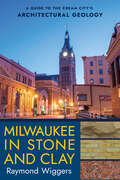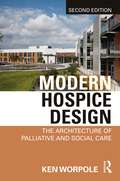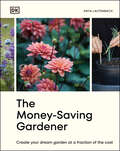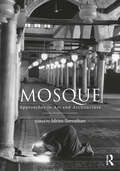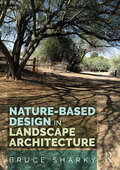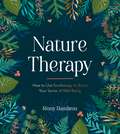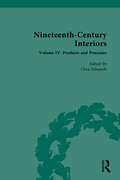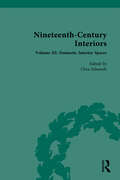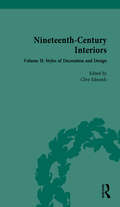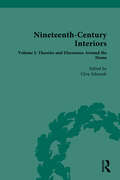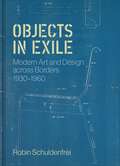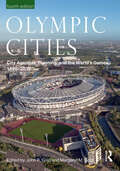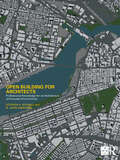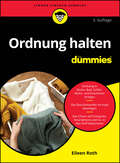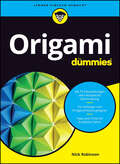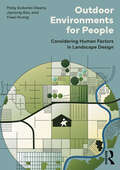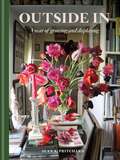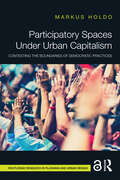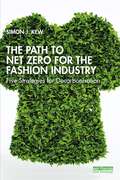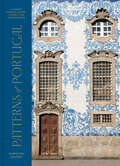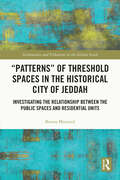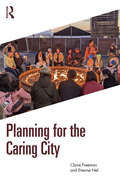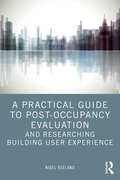- Table View
- List View
Milwaukee in Stone and Clay: A Guide to the Cream City's Architectural Geology
by Raymond WiggersMilwaukee in Stone and Clay follows directly in the footsteps of Raymond Wiggers's previous award-winning book, Chicago in Stone and Clay. It offers a wide-ranging look at the fascinating geology found in the building materials of Milwaukee County's architectural landmarks. And it reveals the intriguing and often surprising links between science, art, and engineering. Laid out in two main sections, the book first introduces the reader to the fundamentals of Milwaukee's geology and its amazing prehuman history, then provides a site-by-site tour guide. Written in an engaging, informal style, this work presents the first in-depth exploration of the interplay among the region's most architecturally significant sites, the materials they're made of, and the sediments and bedrock they're anchored in. Raymond Wiggers crafted Milwaukee in Stone and Clay as an informative and exciting overview of this city. His two decades of experience leading architectural-geology tours have demonstrated the popularity of this approach and the subject matter.
Modern Hospice Design: The Architecture of Palliative and Social Care
by Ken WorpoleThe new edition of this acclaimed book comprehensively updates its timely advocacy of the need for good quality palliative care, today more necessary than ever. Rooted in the social history of the care of the elderly and terminally ill, Modern Hospice Design: The Architecture of Palliative and Social Care takes cognisance of the new conditions of social care in the 21st century, principally in the UK, Europe and North America. It does so with regard to the development of new building types, but also in response to new philosophies of palliative care and the status of the elderly and the dying. Benefitting from a clearer methodological approach and conceptual framework, the expanded book allows a broad section of readers to navigate the text more easily. At its core is a public discussion of a philosophy of design for providing care for the elderly and the vulnerable, taking the importance of architectural aesthetics, the use of quality materials, the porousness of design to the wider world, and the integration of indoor and outdoor spaces as part of the overall care environment. In doing so it advocates care settings that, in the words of Maggie Jencks whose life and ideas inspired the Maggie’s Centres, ‘rise to the occasion’. Including new chapters and new in-depth case studies, complete will full colour illustrations, this book is for architects and interior designers and their students, healthcare professionals, social care providers, estate and facility managers, hospital administrators and Healthcare Trust Boards.
The Money-Saving Gardener: Create Your Dream Garden at a Fraction of the Cost
by Anya LautenbachBeat the rising cost of living and transform your garden on a budget with Anya the Garden Fairy.The Money-Saving Gardener reveals the tips and tricks to keeping costs down without compromising on style or impact. Learn how to repurpose what you have and give new life to second-hand garden furniture; discover savvy cheats to keep hard landscaping costs low; and boost your plant collection for next to nothing with seed-saving and propagation hacks. Revealing the plants that will give you the best long-term value for money, tips for choosing the varieties that will thrive in your garden year after year, and projects for making the most of your propagated cuttings and seedlings, The Money-Saving Gardener proves that a stunning garden doesn&’t need to cost the earth or break the bank.
Mosque: Approaches to Art and Architecture
by Idries TrevathanMosque examines the history, culture, evolution and functions of the Muslim house of worship through the prism of its artistic objects and architectural elements. Contributors present a range of elements, from dome to mihrab, to mosque furniture including lamps, prayer rugs and Qur’an stands. In addition, the book draws attention to the importance of mosque heritage through special projects and initiatives that study, preserve and revitalize the traditional arts of the mosque. This unique book brings together prominent architects, art historians, artists, historians and curators to explore innovative approaches towards the study of mosques through the presentation of original research and insights about mosque-related cultural objects. It is essential reading for anyone interested in the art and culture of the Muslim world.
Nature-Based Design in Landscape Architecture
by Bruce SharkyNature-Based Design in Landscape Architecture showcases a range of built works designed by landscape architects from many countries of the world representing diverse environmental regions and uses. These projects demonstrate the transformative potential of a nature-based approach to landscape architecture.The nature-based design approach supports and encourages natural regeneration with a view to promoting sustainable environments, preserving natural resources, and mitigating the impacts of climate change and development. The projects selected for this book demonstrate the potential of nature-based landscape design to support healthy, natural and managed ecosystems, sequester carbon, and support the recovery of biodiversity. In addition to examples of design-led environmental interventions, Nature-Based Design in Landscape Architecture, the book, also demonstrates the potential for nature-based design to improve people’s relationship with their surroundings by encouraging them to be active participants in their communities. As such, each project featured in the book promotes a discussion around future scenarios in which landscape architects can and will be engaged, from minimizing environmental impact through sustainable design to fostering social justice through community engagement.This book will be a welcome supplement for undergraduate landscape architecture, survey or design studio courses, and may also be used at the master’s degree level either as part of a landscape architecture survey seminar or early design studio.
Nature Therapy: How to Use Ecotherapy to Boost Your Sense of Well-Being
by Rémy DambronNature therapy is the practice of reconnecting with the natural world to refresh your physical and mental well-being. Including tips to help you discover your connection with the outdoors, activity inspiration and a holistic approach to wellness, this book is the ultimate guide to unlocking the transformative power of nature.
Nature Therapy: How to Use Ecotherapy to Boost Your Sense of Well-Being
by Rémy DambronNature therapy is the practice of reconnecting with the natural world to refresh your physical and mental well-being. Including tips to help you discover your connection with the outdoors, activity inspiration and a holistic approach to wellness, this book is the ultimate guide to unlocking the transformative power of nature.
Nineteenth-Century Interiors: Volume IV: Products and Processes
by Clive EdwardsThis volume of primary source materials documents the essential practical aspects of making a home, decorating it and then furnishing it. The crucial constitutive parts that make up an interior from floor to ceiling are considered here in detail. The role of advice books and articles that attempted to direct homemakers in particular directions are examined, as are the more practical how-to publications that demonstrated the processes of interior decoration. Accompanied by extensive editorial commentary, this collection will be of great interest to students and scholars of art history.
Nineteenth-Century Interiors: Volume III: Domestic Interior Spaces
by Clive EdwardsThis volume of primary source materials documents the spatial layouts of the nineteenth century home as they often became more precisely planned with rooms for specific purposes being developed. The styles began to truly reflect the owner’s taste and position. The range is of course vast from single room dwellings to large-scale mansions and numerous variations in-between. Accompanied by extensive editorial commentary, this collection will be of great interest to students and scholars of art history.
Nineteenth-Century Interiors: Volume II: Styles of Decoration and Design
by Clive EdwardsThis volume of primary source materials documents the nineteenth-century search for a representative style, and the alternating fashions for interiors that demonstrated the consumerism of the period. Although in some senses every interior is unique so that a style canon may seem to be meaningless, there have been important historical trends or styles that have influenced individual interiors, and these have formed the groundwork from which other styles and tastes have developed and changed. Accompanied by extensive editorial commentary, this collection will be of great interest to students and scholars of art history.
Nineteenth-Century Interiors: Volume I: Theories and Discourses Around the Home
by Clive EdwardsThis volume of primary source materials documents the nature of the home and the theories and discussions around the concept. It examines the class divisions that become evident with the ostentatious lifestyles of political and society hostesses at the peak, whilst middle-class housing often in suburbia, seemed to have created a separation of home and work, arguably suggesting men and women lived in separate spheres. Working-class interiors, often seen the eyes of middle-class observers, were at the bottom of the hierarchy and often reflected concerns of social inequality and misery. The documents also address the process of purchasing and decorating a home, advice on decoration and home management, the nature of taste and comfort, and the symbolic roles of the home as an anchor in society. Accompanied by extensive editorial commentary, this collection will be of great interest to students and scholars of art history.
Objects in Exile: Modern Art and Design across Borders, 1930–1960
by Robin SchuldenfreiAn essential examination of how emigration and resettlement defined modernismIn the fraught years leading up to World War II, many modern artists and architects emigrated from continental Europe to the United States and Britain. The experience of exile infused their modernist ideas with new urgency and forced them to use certain materials in place of others, modify existing works, and reconsider their approach to design itself. In Objects in Exile, Robin Schuldenfrei reveals how the process of migration was crucial to the development of modernism, charting how modern art and architecture was shaped by the need to constantly face—and transcend—the materiality of things.Taking readers from the prewar era to the 1960s, Schuldenfrei explores the objects these émigrés brought with them, what they left behind, and the new works they completed in exile. She argues that modernism could only coalesce with the abandonment of national borders in a process of emigration and resettlement, and brings to life the vibrant postwar period when avant-garde ideas came together and emerged as mainstream modernism. Examining works by Walter Gropius, László Moholy-Nagy, Lucia Moholy, Herbert Bayer, Anni and Josef Albers, and others, Schuldenfrei demonstrates the social impact of art objects produced in exile.Shedding critical light on how the pressures of dislocation irrevocably altered the course of modernism, Objects in Exile shows how artists and designers, forced into exile by circumstances beyond their control, changed in unexpected ways to meet the needs and contexts of an uncertain world.
Olympic Cities: City Agendas, Planning, and the World’s Games, 1896 – 2032 (ISSN)
by John R. Gold Margaret M. GoldThe first edition of Olympic Cities, published in 2007, provided a pioneering overview of the changing relationship between cities and the modern Olympic Games. This substantially revised and much enlarged fourth edition builds on the success of its predecessors. The first of its three parts provides overviews of the urban legacy of the four component Olympic festivals: the Summer Games; Winter Games; Cultural Olympiads; and the Paralympics. The second part comprises systematic surveys of six key aspects of activity involved in staging the Olympics and Paralympics: finance; sustainability; the creation of Olympic Villages; security; urban regeneration; and tourism. The final part consists of ten chronologically arranged portraits of host cities from 1960 to 2032, with complete coverage of the Summer Games of the twenty-first century.As controversy over the growing size and expense of the Olympics, with associated issues of democratic accountability and legacy, continues unabated, this book’s incisive and timely assessment of the Games’ development and the complex agendas that host cities attach to the event will be essential reading for a wide audience. This will include not just urban and sports historians, urban geographers, event managers, and city planners, but also anyone with an interest in the staging of mega-events and concerned with building a better understanding of the relationship between cities, sport, and culture.
Open Building for Architects: Professional Knowledge for an Architecture of Everyday Environment (Open Building)
by Stephen H. Kendall N. John HabrakenOpen Building is an internationally recognized approach to the design of buildings and building complexes with roots in the way the ordinary built environment grows and regenerates. The Open Building approach recognizes that both stability and change are realities to be managed in the contemporary built environment. Buildings – and the neighborhoods they occupy – are not static during the most stable times or during times of rapid social and technical change. They are living organisms that need constant adjustments to remain attractive, safe and valuable.Using case studies of built projects from around the world, this book explains the Open Building approach and discusses important characteristics of everyday built environment that the Open Building approach designs for. It also presents a key method that can be used to put the approach into use. It addresses questions such as: How can we design large projects for inevitable change? How can we balance the demands of large projects for efficient implementation with the need for ‘fine-grained’ decision-making control? How can we separate design tasks, one task being the design of what should last a century, the other task being the design of more mutable units of occupancy? How can we identify and share architectural themes and, at the same time, make variations on them? How can we use the Open Building approach to steward the earth’s scarce resources and contribute to a circular economy that benefits all people? This book is an essential resource for practitioners, investors and developers, regulators, builders, product manufacturers and educators interested in why the Open Building approach matters and how to practice Open Building.
Ordnung halten für Dummies (Für Dummies)
by Eileen RothDamit Tohuwabohu ein Fremdwort bleibt Haben Sie es satt, ewig Ihren Schlüssel zu suchen und ihn später im Kühlschrank wiederzufinden? Ordnung halten: Dem einen ist es einfach gegeben, die anderen müssen es mühsam lernen. Eileen Roth zeigt Ihnen, wie Sie Ihr Zuhause ordentlich halten und Ihren Arbeitsplatz effizient gestalten. Außerdem erfahren Sie, wie Sie Ihre Daten auf Computer, Smartphone und Co. ordnen und Ihren Urlaub so planen, dass Sie richtig entspannen. Wenn Sie gut organisiert sind, haben Sie weniger Arbeit, weniger Stress, mehr Freizeit und mehr Entspannung. Mithilfe dieses Buches finden Sie immer, was Sie suchen Sie erfahren Welche Hilfsmittel Ihnen beim Ordnen helfen Was Sie aufheben sollten und was nicht Welche grundlegenden Techniken es für das Zeitmanagement gibt Wie Sie das Chaos mit System beseitigen
Origami für Dummies (Für Dummies)
by Nick RobinsonMehr als nur Papiertiger Wollten Sie schon immer die uralte Kunst des Origami meistern? Dann ist dieses Buch genau das Richtige für Sie. Verständliche Schritt-für-Schritt-Anleitungen, bestehend aus Abbildungen und begleitendem Text, helfen Ihnen dabei, ein langweiliges Stück Papier in die verschiedensten Origami-Modelle zu verwandeln. Egal ob Anfänger oder Fortgeschrittener - für jeden ist das richtige dabei. Dabei gibt der Autor auch allgemeine Tipps zur perfekten Faltung, zum Erstellen eigener Modelle und verrät, was zu tun ist, wenn Sie mal nicht weiterwissen. So werden auch Sie zum Origami-Meister. Sie erfahren Wie Sie Grundformen falten und Papier einteilen Wie Sie neue Origami-Modelle entwerfen Wie Sie auch knifflige Modelle meistern Wie Sie mithilfe von Origami Spinnen lebend aus Ihrer Wohnung entfernen
Outdoor Environments for People: Considering Human Factors in Landscape Design
by Patsy Eubanks Owens Jayoung Koo Yiwei HuangOutdoor Environments for People addresses the everyday human behavior in outdoor built environments and explains how designers can learn about and incorporate their knowledge into places they help to create. Bridging research and practice, and drawing from disciplines such as environmental psychology, cultural geography, and sociology, the book provides an overview of theories, such as personal space, territoriality, privacy, and place attachment, that are explored in the context of outdoor environments and, in particular, the landscape architecture profession. Authors share the impact that place design can have on individuals and communities with regard to health, safety, and belonging. Beautifully designed and highly illustrated in full color, this book presents analysis, community engagement, and design processes for understanding and incorporating the social and psychological influences of an environment and discusses examples of outdoor place design that skillfully respond to human factors. As a textbook for landscape architecture students and a reference for practitioners, it includes chapters addressing different realms of people–place relationships, examples of theoretical applications, case studies, and exercises that can be incorporated into any number of design courses. Contemporary design examples, organized by place type and illustrating key human factor principles, provide valuable guidance and suggestions. Outdoor Environments for People is a must-have resource for students, instructors, and professionals within landscape architecture and the surrounding disciplines.
Outside In: A Year of Growing & Displaying
by Sean A Pritchard'Inventive, considered, and thoughtful design.' House & GardenIn his debut book, garden designer Sean A Pritchard shows you how to plan a garden so that every month of the year there's something to bring indoors and display in an engaging way. From the cheery joy of early spring daffodils to the velvety richness of late-summer dahlias, the deep glow of golden autumn leaves to the optimism of late-winter catkins, Sean explains how to grow, harvest, and arrange an abundance of nature's treasure - no matter the size of your plot or your level of horticultural experience.
Outside In: A Year of Growing & Displaying
by Sean A Pritchard'Inventive, considered, and thoughtful design.' House & GardenIn his debut book, garden designer Sean A Pritchard shows you how to plan a garden so that every month of the year there's something to bring indoors and display in an engaging way. From the cheery joy of early spring daffodils to the velvety richness of late-summer dahlias, the deep glow of golden autumn leaves to the optimism of late-winter catkins, Sean explains how to grow, harvest, and arrange an abundance of nature's treasure - no matter the size of your plot or your level of horticultural experience.
Participatory Spaces Under Urban Capitalism: Contesting the Boundaries of Democratic Practices (Routledge Research In Planning And Urban Design Ser.)
by Markus HoldoCan people use new participatory spaces to reclaim their rights as citizens and challenge structures of political power? This book carefully examines the constraints and possibilities for participatory governance under capitalism. To understand what is at stake in the politics of participation, we need to look beyond the values commonly associated with it. Citizens face a dilemma: should they participate, even if this helps to sustain an unjust system, or not participate, thereby turning down rare opportunities to make a difference? By examining the rationale behind democratic innovation and the reasons people have for getting involved, this book provides a theory of how citizens can use new democratic spaces to challenge political boundaries. Connecting numerous international case studies and presenting original research from Rosario, Argentina, this book offers a crucial corrective to previous research. What matters most is not the design of new models of participation nor is it the supposed radical imagination of political leaders. It is whether people use new spaces for participation to renegotiate what democracy means in practice. Bridging critical urban studies and democratic theory, this book will be of interest to researchers and students in the fields of democratic innovations, political economy and urban planning. It will also provide activists and practitioners of participatory democracy with important tools to expand spaces of grassroots democracy.
The Path to Net Zero for the Fashion Industry: Five Strategies for Decarbonisation
by Simon J. KewThis book uses a quantitative science-based approach to explain where the greenhouse gas (GHG) emissions emitted by the fashion industry are generated and it explores what strategies can be deployed to achieve Net Zero by 2050. With GHG emissions currently predicted to triple by the middle of the century, the fashion industry is far off course to reach Net Zero, as set out in the Paris Agreement. With misinformation and greenwashing representing an ever-growing barrier to potential solutions, the book aims to demystify the source of GHG emissions from the industry, breaking down in detail their origin, while identifying the steps that can be taken when designing and sourcing new products. Detailing the market drivers and trends in fashion consumption, it argues that change should be guided by science-based quantitative principles. Accessibly written with key insights at the end of each chapter, this book will enable the reader to understand the tactics to tackle decarbonisation, and ultimately outline five main strategies that can be deployed by the fashion and textile industries to align with the Paris Agreement. This book serves as a practical guide for designers, buyers and the fashion industry in general to develop and understand approaches and strategies to reduce energy consumption and the resulting GHG emissions to reach Net Zero.
Patterns of Portugal: A Journey Through Colors, History, Tiles, and Architecture
by Christine ChitnisA vibrant tour of Portugal, featuring more than 200 photographs that bring to life one of the most beautiful countries in the world.In this gorgeous book, writer and photographer Christine Chitnis invites you to celebrate the unique, timeless beauty of Portugal through the stunning designs and hues that define Portugal&’s countryside, coast, small towns, and cosmopolitan cities.This collection features over 200 stunning photographs that illustrate the ways that color and pattern are woven into the very fabric of the country&’s culture, history, architecture, and traditions. Each section features insightful essays that explore the artistry of azulejos, the colorful ceramic tiles covering much of Portugal's architecture; the intricately embroidered details of traditional lavradeira costumes; the rich flavors of Portuguese cuisine, and so much more.Throughout these vibrant pages, you&’ll discover the vivid stories behind each color and pattern, transporting you to the gorgeous fields of Alentejo, the sparkling waters of the Algarve, the busy streets of Lisbon, the lush valleys of the Douro, and beyond.
“Patterns” of Threshold Spaces in the Historical City of Jeddah: Investigating the Relationship Between the Public Spaces and Residential Units (Architecture and Urbanism in the Global South)
by Basma Massoud“Patterns” of Threshold Spaces in the Historical City of Jeddah explores the meaning of threshold spaces and investigates the relationship between the public spaces and residential units in the historical city of Jeddah, Saudi Arabia, while at the same time revisiting Christopher Alexander’s theory in his canonical 1977 book, A Pattern Language. This book questions and analyses “patterns” relating to the cultural, social, and environmental particularities of Jeddah, with special attention paid to the effect of gender segregation in the city’s urban configuration. It discusses the extension that has been undertaken through testing a concept from the urban design theory of the West (the United States and Canada) and applying it to an Islamic city to find patterns in four different scales, which form the basis of the investigation (body, building, street, and city). Empirical methods have been used in the context of historical Jeddah, through which patterns are investigated using different approaches for the different scales. The book aims to explore the meaning of threshold spaces in old Jeddah. Furthermore, it shows that there are eighteen patterns of threshold spaces in the old town: patterns that are solely related to this specific case study, as well as modified patterns to the ones explored by Christopher Alexander. This book shall allow not only a better understanding of the relationship between housing and the historical city but also an exploration of the role of the threshold space in shaping the old city of Jeddah. It will be of interest to researchers, students of architecture, urban planning and anthropology studies, and people involved in cultural heritage, both academics and practitioners.
Planning for the Caring City
by Claire Freeman Etienne NelAs the world has become increasingly urbanised and planetary well-being ever more threatened, questions have emerged over just what the priorities should be for how we live in cities. Clearly for many the current ways of planning and managing city environments are not working, given so many of their human and non-human inhabitants struggle on a daily basis to maintain their well-being and survival. Different approaches to city development are crucial if they are to be inclusive places where all can thrive. Ensuring that cities are safe and sustainable and provide a level of care for all their residents places a significant mandate on those who manage cities and on planners in particular. This book examines all the parts of the city where care needs to be incorporated, how we plan, create nurturing environments, include all who live there, build sensitively, support meaningful livelihoods, and enable compassionate governance. With planners in mind this book examines why care is needed in the urban environment, and drawing on real world examples examines how it can be applied in an effective and empowering fashion.
A Practical Guide to Post-Occupancy Evaluation and Researching Building User Experience
by Nigel OselandA Practical Guide to Post-Occupancy Evaluation offers high-level pragmatic guidance and case study examples on how to conduct a Post-Occupancy Evaluation (POE) to determine whether a workplace project is successful and uncover the lessons learned for future projects. For designers, POEs provide essential predesign feedback, informing the design brief to determine occupant requirements and help focus expenditure. For those in charge of a building or buildings, POE offers proactive building management and can also be used as part of the change management programme in larger projects, informing the occupants of progress. The practical guidance offered in this book will help the workplace industry understand if a design meets the requirements of an occupier and measure the success of and value offered by a workplace project. This book will be of interest to professionals in the workplace industry responsible for delivering and evaluating capital projects as well as those studying interior design, architecture, surveying, facilities management and building services engineering.
